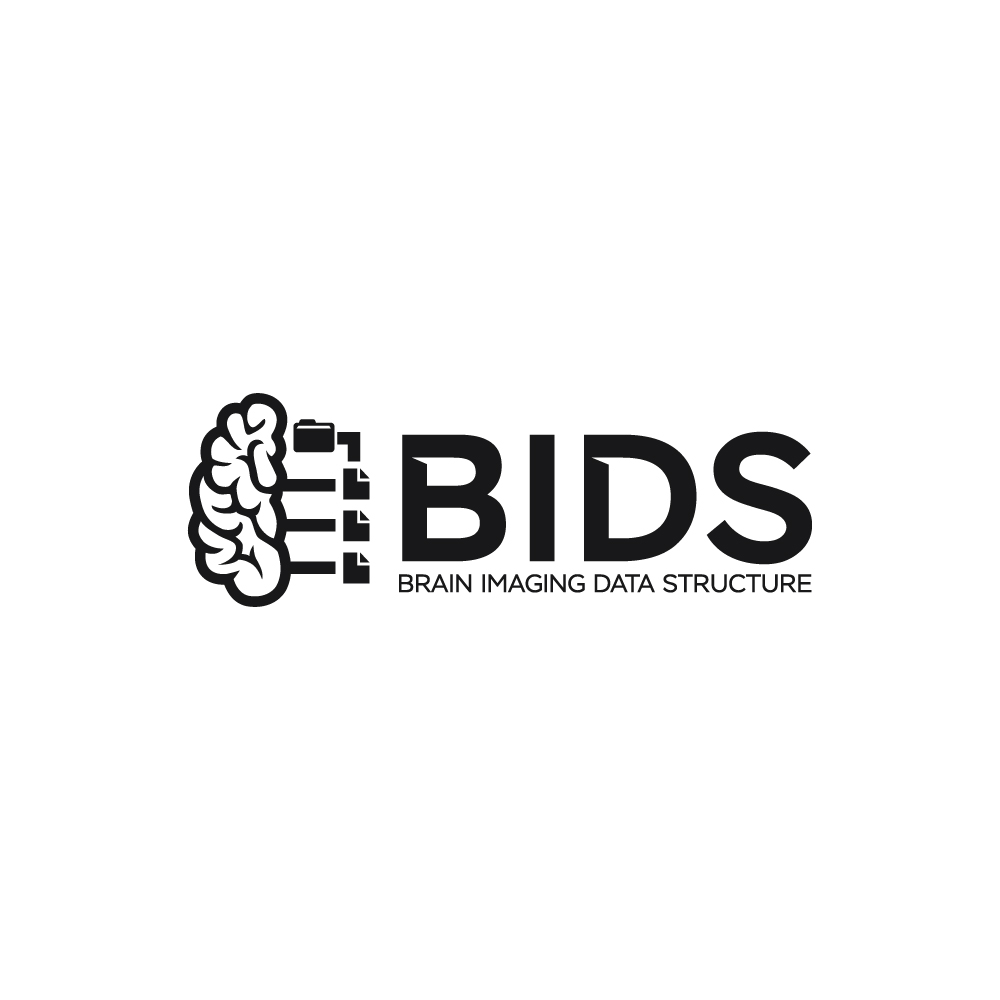Common data types and metadata
Contents
Common data types and metadata#
Common file level metadata fields#
Each derivative data file SHOULD be described by a JSON file provided as a sidecar or higher up in the hierarchy of the derived dataset (according to the Inheritance Principle) unless a particular derivative includes REQUIRED metadata fields, in which case a JSON file is also REQUIRED. Each derivative type defines their own set of fields, but all of them share the following (non-required) ones:
Examples#
Preprocessed bold NIfTI file in the original coordinate space of the original run.
The location of the file in the original datasets is encoded in the RawSources metadata,
and _desc-<label>
is used to prevent clashing with the original filename.
{
"RawSources": ["sub-01/func/sub-01_task-rest_bold.nii.gz"]
}
If this file was generated with prior knowledge from additional sources, such as
the same subject’s T1w, then both files MAY be included in RawSources.
{
"RawSources": [
"sub-01/func/sub-01_task-rest_bold.nii.gz",
"sub-01/anat/sub-01_T1w.nii.gz"
]
}
On the other hand, if a preprocessed version of the T1w image was used, and it also
occurs in the derivatives, Sources and RawSources can both be specified.
{
"Sources": [
"sub-01/anat/sub-01_desc-preproc_T1w.nii.gz"
],
"RawSources": [
"sub-01/func/sub-01_task-rest_bold.nii.gz"
]
}
Spatial references#
Derivatives are often aligned to a common spatial reference to allow for the
comparison of acquired data across runs, sessions, subjects or datasets.
A file may indicate the spatial reference to which it has been aligned using the
space entity and/or the SpatialReference metadata.
The space entity may take any value in
Image-Based Coordinate Systems.
If the space entity is omitted,
or the space is not in the Standard template identifiers table,
then the SpatialReference metadata is REQUIRED.
SpatialReference key allowed values#
Value |
Description |
|---|---|
|
A (potentially unique) per-image space. Useful for describing the source of transforms from an input image to a target space. |
URI or path |
This can be used to point to a specific file. Paths are written relative to the root of the derivative dataset. |
In the case of images with multiple references, an object must link the relevant structures to reference files.
If a single volumetric reference is used for multiple structures, the VolumeReference key MAY be used to reduce duplication.
For CIFTI-2 images, the relevant structures are BrainStructure values defined in the BrainModel elements found in the CIFTI-2 header.
Examples#
Preprocessed bold NIfTI file in individual coordinate space. Please mind
that in this case SpatialReference key is REQUIRED.
{
"SpatialReference": "sub-01/anat/sub-01_desc-combined_T1w.nii.gz"
}
Preprocessed bold CIFTI-2 files that have been sampled to the fsLR surface
meshes defined in the Conte69 atlas along with the MNI152NLin6Asym template.
In this example, because all volumetric structures are sampled to the same
reference, the VolumeReference key is used as a default, and only the
surface references need to be specified by BrainStructure names.
{
"SpatialReference": {
"VolumeReference": "https://templateflow.s3.amazonaws.com/tpl-MNI152NLin6Asym_res-02_T1w.nii.gz",
"CIFTI_STRUCTURE_CORTEX_LEFT": "https://github.com/mgxd/brainplot/raw/master/brainplot/Conte69_Atlas/Conte69.L.midthickness.32k_fs_LR.surf.gii",
"CIFTI_STRUCTURE_CORTEX_RIGHT": "https://github.com/mgxd/brainplot/raw/master/brainplot/Conte69_Atlas/Conte69.R.midthickness.32k_fs_LR.surf.gii"
}
}
Preprocessed or cleaned data#
Template:
<pipeline_name>/
sub-<label>/
<datatype>/
<source_entities>[_space-<space>][_desc-<label>]_<suffix>.<ext>
Data is considered to be preprocessed or cleaned if the data type of the input,
as expressed by the BIDS suffix, is unchanged.
By contrast, processing steps that change the number of dimensions are likely to disrupt
the propagation of the input’s suffix and generally, the outcomes of such transformation
cannot be considered preprocessed or cleaned data.
Examples of preprocessing:
Motion-corrected, temporally denoised, and transformed to MNI space BOLD series
Inhomogeneity corrected and skull stripped T1w files
Motion-corrected DWI files
Time-domain filtered EEG data
MaxFilter (for example, SSS) cleaned MEG data
The space entity
is recommended to distinguish files with different underlying
coordinate systems or registered to different reference maps.
See Spatial references for details.
The desc entity (“description”)
is a general purpose field with freeform values,
which SHOULD be used to distinguish between multiple different versions of
processing for the same input data.
Examples of preprocessed data:
All REQUIRED metadata fields coming from a derivative file’s source file(s) MUST
be propagated to the JSON description of the derivative unless the processing
makes them invalid (for example, if a source 4D image is averaged to create a single
static volume, a RepetitionTime property would no longer be relevant).

